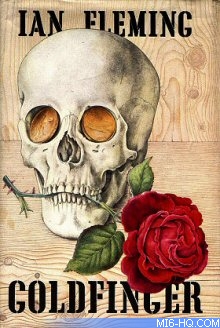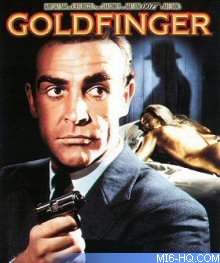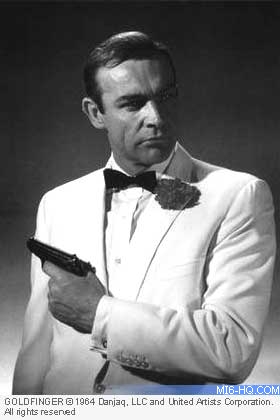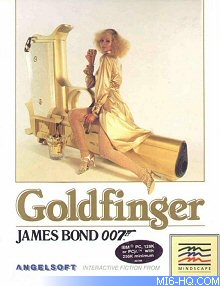|
|
|
 |
| |
MI6 tracks the legacy of Goldfinger, from Ian Fleming's
novel, to the comic strip adaptation, feature film
and computer game...
|
|
Goldfinger - The Legacy
Summary
Goldfinger was the seventh James Bond novel by Ian Fleming,
first published in 1959. It was the third film in the official
Eon Productions series, starring Sean Connery as 007 for the
third time. Released in 1964, the film was produced by Albert
R. Broccoli and Harry Saltzman, and directed by Guy Hamilton.
The Daily Express began the comic strip adaptation by Henry
Gammidge and artist John McLusky on 3rd October 1960. |
|
|
The Novel
Ian Fleming penned his seventh
James Bond title in 1958, and was published by Glidrose on 23rd
March 1959. Goldfinger marked two transitional points in the literary
series: Bond becomes increasingly obsessed with morality, and
the plot is peppered with gadgetry and high technology.
 Goldfinger Literary Coverage
Goldfinger Literary Coverage
James Bond is faced with Goldfinger, a millionaire who
cheats at cards and golf. He discovers evidence that Goldfinger
is the treasurer of SMERSH, and as the game is played out,
007 finds that the real stakes are greater still. Goldfinger
plans to steal gold from Fort Knox to fund SMERSH and to
increase his personal stock.
"We are going to burgle fifteen billion dollars’
worth of gold bullion, approximately half the supply of
mined gold in the world. We are going, Mr Bond, to take
Fort Knox."
Trivia: The villain's name was borrowed from Fleming's
neighbour, architect Erno Goldfinger, and his character
bears some resemblance.
|
|

Above: First edition cover art |
"Man has climbed Mount Everest. Gone
to the bottom of the ocean. He has fired rockets at the Moon.
Split the atom. Achieved miracles in every field of human endeavour...
except crime!"
The Comic Strip
Ian Fleming's original novel was adapted as a daily comic strip
which was published in the Daily Express (UK) newspaper and syndicated
around the world. The adaptation ran from 3rd October 1960 to
1st April 1961. The adaptation was written by Henry Gammidge and
illustrated by John McLusky, and was largely faithful to the original
material, with only a couple of small alterations.
 Goldfinger Comic Strip Coverage
Goldfinger Comic Strip Coverage
 Above: The opening panel of "Goldfinger"
(syndicated version)
Above: The opening panel of "Goldfinger"
(syndicated version) |
Goldfinger: "In Chicago, Mr Bond, they have a saying:
once is happenstance, twice is coincidence, the third time is
enemy action. Miami, Sandwich and now Geneva..."
| Trivia: The British version of "Goldfinger" was
censored to remove Oddjob's knife in strip #829, whereas some
syndicated versions keep it in place. |
|
Published: 3rd October 1960 (UK)
Preceded By: Dr. No
Followed By: Risico |
|
The Film
The film was produced by Albert R. Broccoli and Harry Saltzman,
and directed by Guy Hamilton, with a screenplay by Richard
Maibaum and Paul Dehn. The headline cast starred Sean
Connery as James Bond, Honor
Blackman as Pussy Galore, Gert
Frobe as Auric Goldfinger and Harold
Sakata as Oddjob.
 Goldfinger Movie Coverage
Goldfinger Movie Coverage
Agent 007 investigates a smuggling operation run by the
obsessive millionaire Auric Goldfinger and uncovers a plot
to irradiate the entire gold supply of the United States
by detonating an atomic bomb inside Fort Knox.
Bond: "Do you expect me to talk?"
Goldfinger: "No, Mr Bond, I expect you to die!"
Trivia: Although many of the locations in the film are
American, Sean Connery never set foot in America during
filming.
Released: 17th September 1964 (UK),
22nd December 1964 (US)
Running Time: 111 minutes
Worldwide Box Office: $124.9m
Preceded by: From Russia
With Love
Followed by: Thunderball |
|
|

Above: Special Edition DVD cover art
 Pre-Order - Goldfinger
Pre-Order - Goldfinger
|

Above: Sean Connery as James Bond 007 |
|
The Music
The title track of the same name, Goldfinger, was
the first of three songs performed by Shirley Bassey for
the film series.
 Goldfinger Music Coverage
Goldfinger Music Coverage
Written by John Barry and Anthony Newley, Bassey's theme
sold over a million copies in the United States awarding
her a Gold album. In the United Kingdom the theme reached
number 21 on the charts.
The soundtrack was composed by John Barry, his second Bond
film credit as composer.
The Media
Goldfinger was the first Bond film to be shown on U.S. commercial
TV, on Sunday, 17 September 1972, earning the highest Neilson
ratings for a single movie on TV up to that time. 49% of
the nation's viewers tuned in that night, and ABC-TV, which
showed the film, would retain the exclusive commercial U.S.
TV rights to the Bond series for the next 28 years.
|
The Computer Game
Continuation author Raymond Benson designed and wrote the
interactive text adventure computer game developed by Angelsoft
and released by Mindscape in 1986 for the PC and Apple II.
The game used advanced techniques that allowed you to give
commands in plain English, and featured fully developed
characters that responded realistically. Detailed prose
placed players right in the middle of the action in the
fully rendered all-text adventure.
You must stop Auric Goldfinger from taking the world's
gold supply, stop the destruction of Kentucky, deal with
Pussy Galore and even a fight with Oddjob. Not much for
old 007 to do actually - it's all in a day's work (or is
it adventure)?
Released: 1986
Genre: Text Adventure
Preceded By: A View to A Kill
Followed By: The Living
Daylights |
|
|

Above: Game cover art |
|
|
|